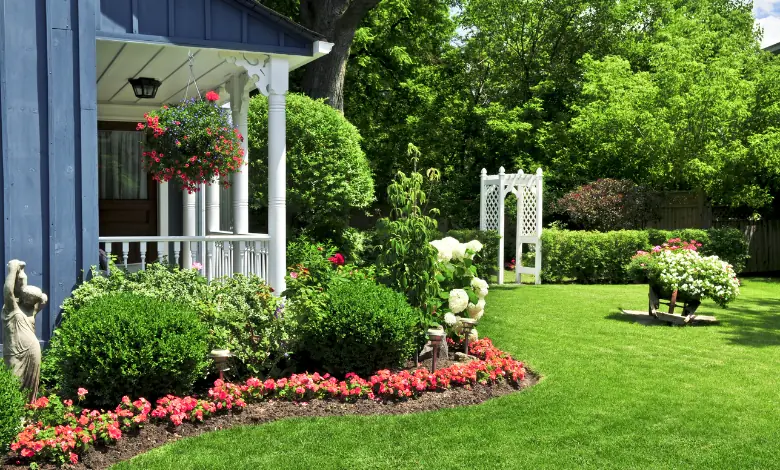10 Things You Should Know About Your Front Lawn and Landscaping

Have you ever considered the impact of a well-maintained front lawn on your home’s value and appeal?
A neat and lush green lawn is not just pleasing to the eyes; it plays a vital role in increasing your property’s worth, creating a positive first impression, and contributing to environmental health.
In the next sections, we will explore the top ten things you should know about your front lawn and landscaping, which will help you transform your front yard into a beautiful, welcoming space.
1. Soil Quality
The quality of your soil is the foundation of a healthy lawn. It provides the nutrients that your grass needs to grow lush and green. However, not all soils are the same, and the soil type in your lawn can greatly affect its health and appearance.
For instance, sandy soils drain quickly but can struggle to retain necessary nutrients. On the other hand, clay soils retain water well but can become easily compacted, preventing roots from getting the air they need. Therefore, understanding your soil type is crucial in lawn maintenance.
One way to improve soil health is through soil amendments like compost or manure, which can boost the nutrient content and improve the structure of your soil. Regular soil testing can also help you keep track of its health and make necessary adjustments to your lawn care routine.
2. Local Climate
Another crucial aspect of keeping a healthy lawn is being aware of your local climate. Different types of grass do better in different temperatures, so it’s important to pick a type of grass that does well in your area. Warm-season grasses like Zoysia or Bermuda might be a good choice if you live in a place where summers are hot and winters are mild.
Depending on your local climate, you should also change your watering routine. If it rains a lot where you live, you might not need to water your yard as much. But if you live in a dry or hot area, your yard may need more watering to stay green and healthy.
3. Plant Selection
Plant selection is a significant aspect of lawn maintenance and landscaping. Choosing the right plants can elevate your lawn’s aesthetic appeal and contribute to local biodiversity. Remember, the plants should not only be visually pleasing but should also be appropriate for your climate and soil type.
Native plants are often a good choice as they are adapted to the local conditions and require less maintenance. They are more likely to thrive, resist local pests, and attract native wildlife. Also, native plants can help preserve the local ecosystem and biodiversity.
Apart from native plants, you could also consider incorporating annuals or perennials in your lawn for a pop of color. While annuals bloom for one season and must be replanted yearly, perennials return year after year. Both can add diversity and visual interest to your front lawn, enhancing its appeal.
4. Lawn Care
Caring for your lawn is a continuous process that requires time and effort. Regular mowing helps maintain the health of your grass, promoting denser growth and discouraging weeds. Always keep your mower blades sharp, as dull blades can damage the grass and make it more susceptible to disease.
Proper watering is another key aspect of lawn care. The best time to water your lawn is early morning when the temperatures are cooler and less water is lost to evaporation. A good rule of thumb is to water deeply and infrequently, encouraging the grass to develop deep roots and making it more stable and drought-resistant.
Lastly, don’t forget to fertilize your lawn. Fertilizers provide essential nutrients your grass might not get from the soil. Follow the recommended application rates and timing for the best results, as over-fertilizing can damage your lawn and the environment.
Also Read: Lawn Care: Can Fertilizer Eliminate Weeds
5. Irrigation System
An efficient irrigation system can make a big difference in maintaining a lush, healthy lawn. It ensures that your lawn receives the right amount of water, enhancing its appearance and health. Proper irrigation can also help conserve water, decreasing utility bills and contributing to environmental sustainability.
Various irrigation systems include sprinkler systems, drip irrigation, and soaker hoses. Sprinkler systems are commonly used for lawns because they cover large areas. Drip irrigation and soaker hoses are more suitable for garden beds and specific plants, delivering water directly to the plant roots.
When choosing an irrigation system, consider your lawn size, plant types, soil condition, and local climate. Regular irrigation system maintenance is also crucial to ensure its efficiency and longevity. This includes checking for leaks, adjusting sprinkler heads, and winterizing the system to protect it from freezing temperatures.
6. Pruning and Trimming
Pruning and trimming are essential parts of landscape maintenance. They keep your plants looking neat and well-kept and can improve their health and longevity. Regular pruning and trimming can help prevent disease from spreading throughout a plant or tree.
Different plants have different pruning needs, and the best time to prune may vary. Generally, the best time to prune most plants is late winter or early spring, but always research specifics for the varieties in your yard. This practice helps to promote healthy growth and flowering.
The tools you use for pruning and trimming make a difference. Always use sharp, clean tools to make neat cuts that heal quickly. Dull or dirty tools can cause damage and introduce disease, impacting the overall health of your landscape.
7. Mulching
Mulching is an important part of gardening and taking care of lawns. Putting a layer of organic or artificial material over your plants and the soil can help keep the soil healthy, stop weeds from growing, and keep the soil from drying out. Mulches are also lovely to look at because they give your beds and edges a neat, finished look.
As they break down, organic mulches, which can be made of wood chips, straw, or compost, make your soil more fertile. They feed the soil with nutrients, encourage microbes to work, and make the soil stronger and better able to hold air and water. But they might need to be replaced more often than artificial mulches.
Inorganic mulches, like rocks, gravel, or landscape cloth, don’t break down, so they don’t need to be changed as often. They keep the earth moist and stop weeds from growing, but they don’t add nutrients to the soil. When picking dirt, you should think about your needs, the weather where you live, and the look you want to achieve.
8. Pest Control
Getting rid of pests effectively is essential for keeping your yard healthy and green. Pests like grubs, bugs, and different kinds of worms can do a lot of damage to your plants and grass. The presence of bugs can be kept at bay by conducting regular checks, correctly identifying pests, and acting quickly.
There are many ways to get rid of pests, such as using natural methods or chemicals. Using natural ways like bringing in good bugs, making your own sprays, or planting plants that keep pests away are all options. As a last option, chemical treatments should only be used in a way that doesn’t hurt the environment or organisms that aren’t the target.
9. Hardscaping Elements
Hardscaping is an important part of gardening, and it can make your front lawn look a lot better. These are things that aren’t living, like patios, walkways, retaining walls, and other structures that make your outdoor area more useful and attractive. Hardscaping that is put with care can bring out certain features of the lawn, make the outdoor space flow, and give it structure.
When planning your hardscaping, you should think about the natural features of your land, the style of your home, and your own tastes. Hardscaping can be done with a variety of materials, such as natural stone, wood, bricks, and concrete, which all have different looks and feels. Keep in mind that concrete features should last a long time and not get damaged by the weather since they are outside.
10. Sustainable Landscaping
Sustainable landscaping ideas are an environmentally conscious approach that respects nature and aims to reduce environmental harm. This approach involves conscious choices about plant selection, water use, and waste management to minimize environmental impact. Sustainable landscaping can also enhance the beauty and health of your garden while conserving resources and supporting local biodiversity.
One of the key principles of sustainable landscaping is to use native plants that are well-suited to the local climate and soil, reducing the need for extra watering and fertilizer. Another important aspect is efficient water use, which can be accomplished by using drought-resistant plants, employing mulching practices to retain water, and installing efficient irrigation systems.
For particularly challenging terrain, such as a sloping yard, you should hire a Hillside Landscaping professional who can implement sustainable solutions that minimize erosion and maximize the use of native plants. These experts have the knowledge and experience to transform even steep, uneven landscapes into beautiful, environmentally conscious outdoor spaces.
Also Read: Why Hire Professional Landscape Maintenance Services?
Unearth the Secrets of Stunning Lawn and Landscaping Today
In conclusion, maintaining a beautiful and healthy lawn is a multi-faceted task that requires attention to many details. Understanding the quality of your soil and local climate and choosing the right plants are crucial first steps.
With these lawn and landscaping tips, you can turn your front lawn into a beautiful garden that makes your home worth more and makes you enjoy being outside more.
Was this article helpful to you? If so, make sure to check out our blog for more useful information and resources.






